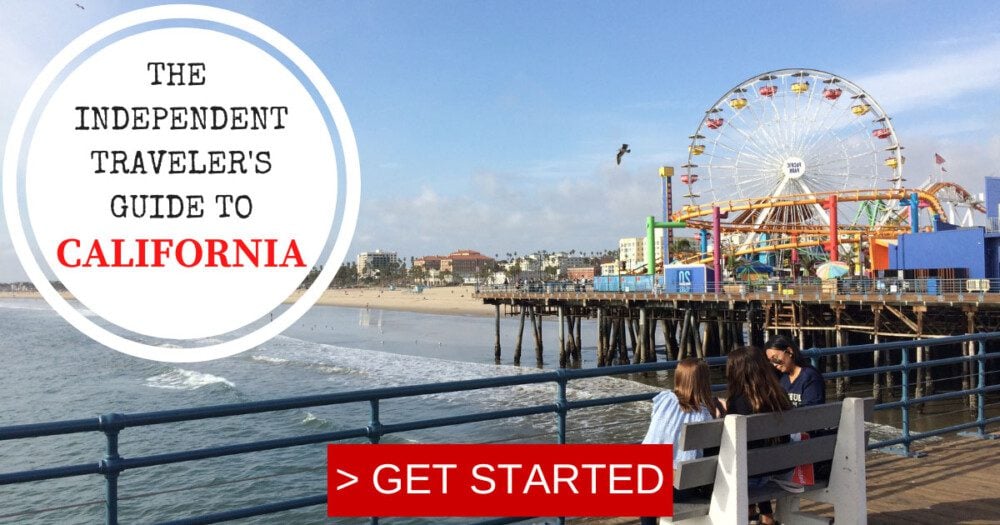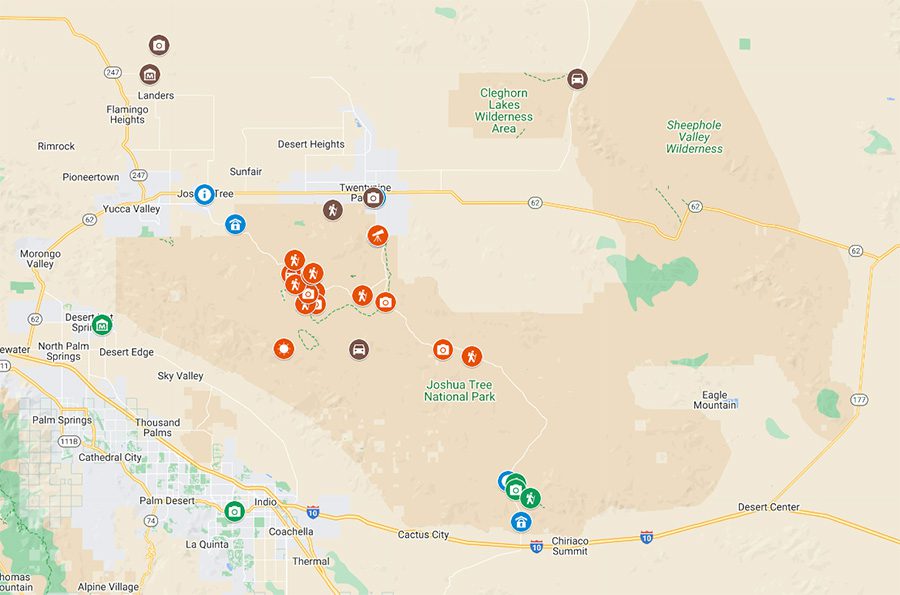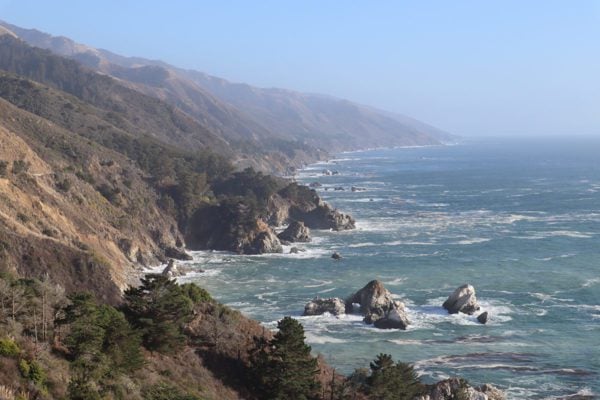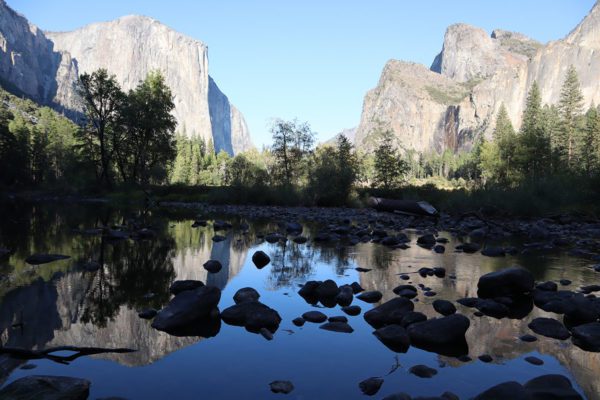Joshua Tree National Park Travel Guide & Itinerary
A short drive from the glitz and glamor of Palm Springs, a visit to Joshua Tree National Park is an essential ingredient of any California Road Trip. Yes, an endless supply of Joshua trees will keep your camera busy, but the park’s unique desert landscape is not to be overlooked. In this Joshua Tree National Park travel guide and itinerary, we’ll explore the best ways of visiting this desert gem.
Despite multiple visits to California, I never managed to make it as far as the Mojave Desert until a recent five-week road trip in the American Southwest. I spent four nights in Palm Springs and Twentynine Palms, spending most of my time hiking and exploring the area’s scenic backcountry roads. This travel guide and Joshua Tree itinerary is based on my experience and extensive research.
Table of contents
- Why Visit Joshua Tree National Park?
- Additional California Travel Resources
- Joshua Tree National Park Itinerary Map
-
Joshua Tree NP Planning Tips
- Where is Joshua Tree National Park?
- How to Get to Joshua Tree National Park?
- When is the Best Time to Visit Joshua Tree National Park?
- How Many Days Do You Need in Joshua Tree National Park?
- Where to Stay in Joshua Tree National Park?
- Getting Around
- What to Do in Joshua Tree National Park
- Water & Food
- Mobile Reception in Joshua Tree NP
- What to Pack for a Trip to Joshua Tree NP
- Pets in Joshua Tree National Park
- Joshua Tree National Park Itinerary
- What’s Next?
- Frequently Asked Questions
Why Visit Joshua Tree National Park?
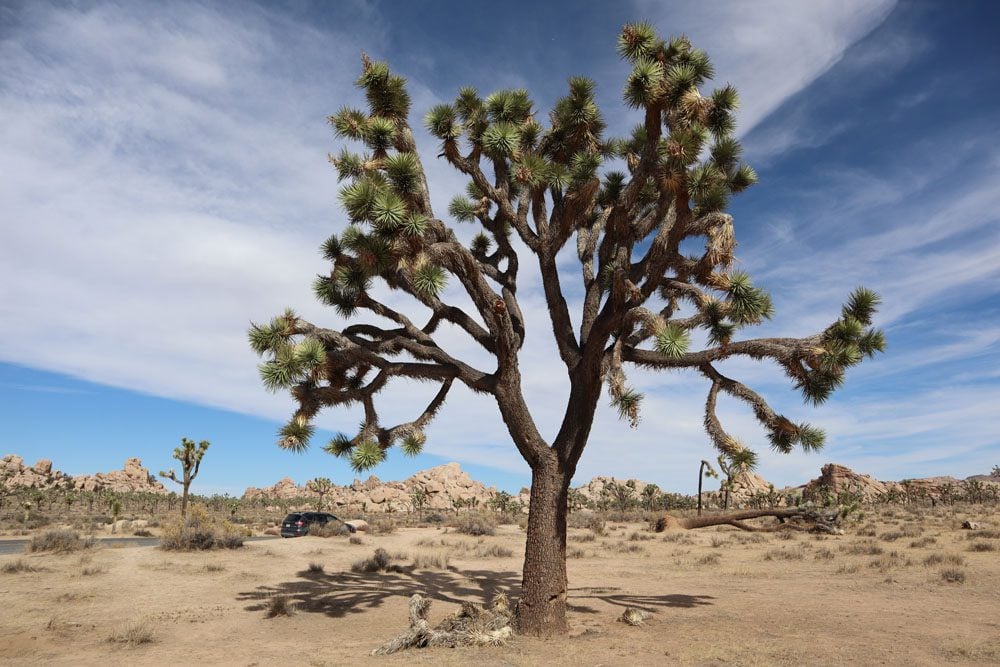
Not technically a tree yet still magnificent, Joshua trees are found throughout the Mojave Desert, but nowhere is their concentration greater than within the national park.
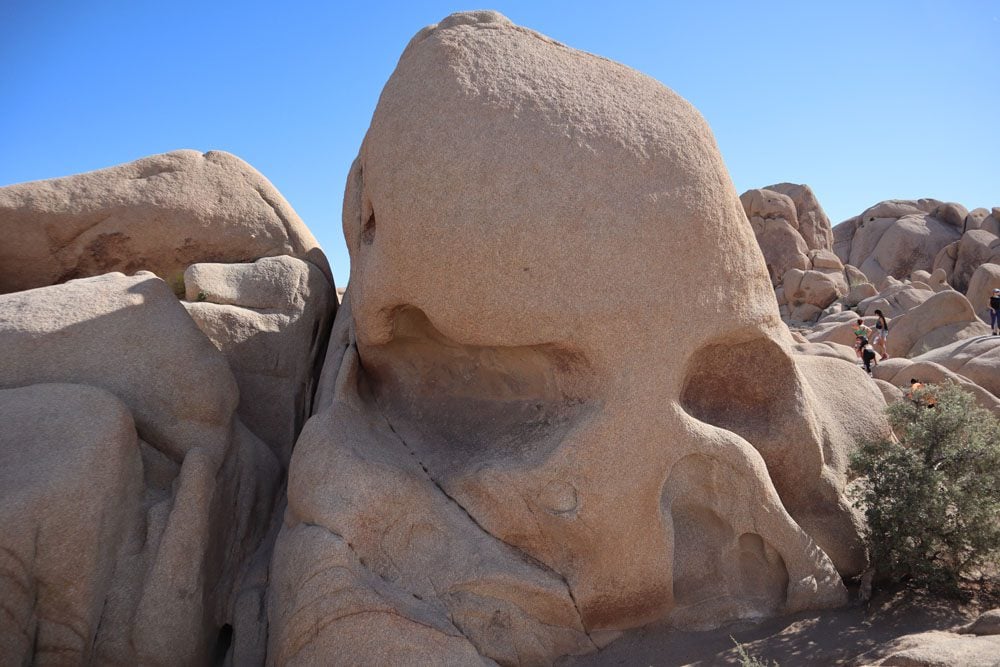
The national park isn’t just about its namesake tree, thanks to an enchanting desert landscape, rich with thorny plants and strange-looking clusters of smooth granite boulders.
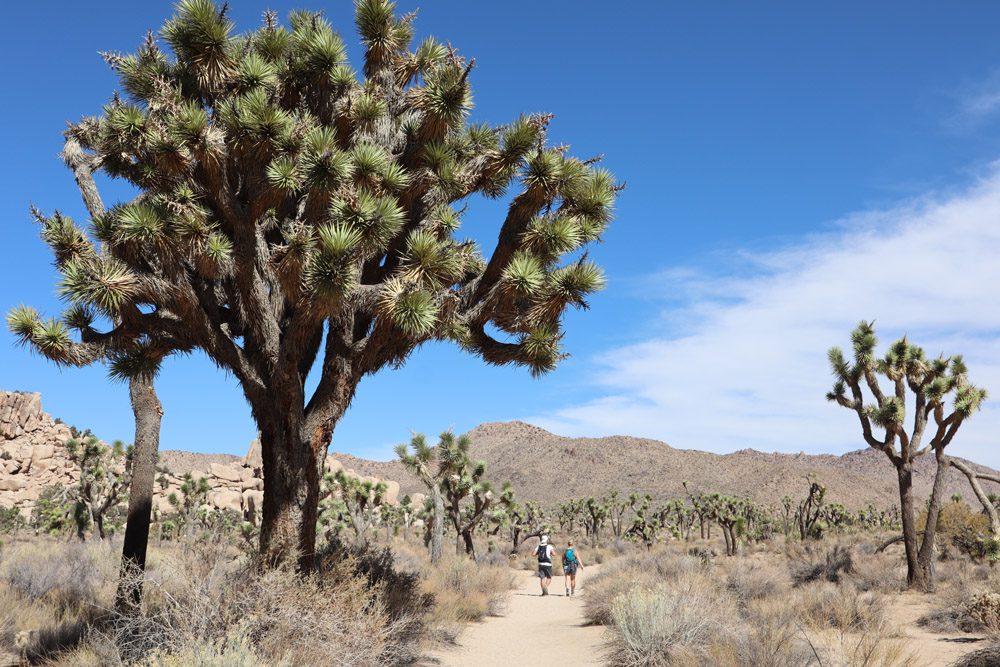
From hikes to abandoned mines and hidden valleys to trails leading to secluded and lush desert oases, put your feet to work on trails suitable for all visitors.
Four sections make up this travel guide:
- Joshua Tree National Park planning tips
- Itinerary for spending 1 to 3 days in Joshua Tree National Park
- The best hikes in Joshua Tree
- Top 10 things to do in Joshua Tree
- Palm Springs and Joshua Tree itinerary
Additional California Travel Resources
Check out additional California and Southwest USA travel guides to combine your visit to Joshua Tree NP with additional highlights.
Joshua Tree National Park Itinerary Map
All places mentioned in this travel guide and itinerary are marked on this companion map. Simply click on the image to open it in Google Maps.
Joshua Tree NP Planning Tips
This section deep dives into the essential ingredients for a successful visit to Joshua Tree and the region.
Where is Joshua Tree National Park?
Joshua Tree National Park is located near Palm Springs in southeast California, in a region where the Mojave Desert meets the Colorado Desert. The national park lies within a day’s driving distance from several major urban areas. To the west, San Diego is 165 miles, and Los Angeles is 130 miles from Joshua Tree National Park. To the east, Phoenix is 220 miles, Tucson is 390 miles, and Las Vegas is 190 miles from the national park when driving through the Mojave National Preserve.
Joshua Tree and Death Valley National Park make a great pair on a classic California desert road trip. Death Valley is 270 miles north of Joshua Tree NP.
How to Get to Joshua Tree National Park?
If you’re not road-tripping to Joshua Tree National Park, fly into the Palm Springs airport and rent a car for the entire stay. There are three ways to enter the national park: the west entrance near the town of Joshua Tree and the Joshua Tree Visitor Center, the north entrance near Twentynine Palms and the Oasis Visitor Center, and the south entrance near the Cottonwood Visitor Center off Interstate 10.

If you’re planning to visit multiple national parks, pre-purchase the America the Beautiful Pass.
When is the Best Time to Visit Joshua Tree National Park?
The best time to visit Joshua Tree National Park is during spring and late fall, when daytime and evening temperatures are optimal. It can get dangerously hot during the summer months, so planning and extreme caution are needed. During winter, daytime temperatures are mild, but nights are very cold. That being said, elevation inside the national park greatly varies, so be aware of microclimates and their seasonal effects.
How Many Days Do You Need in Joshua Tree National Park?
On a one-day visit to Joshua Tree National Park, focus on the more “manageable” northwest section of the park. This is where you’ll find Joshua trees, along with hiking opportunities and scenic roadside stops. You can comfortably cover all the park’s major highlights on a two or three-day visit, including several long hikes.
(1) See the next section of this travel guide for a detailed itinerary for spending up to three days in Joshua Tree National Park. (2) If you’re visiting during the hot summer months, don’t plan to do too much in one day.
Where to Stay in Joshua Tree National Park?
Stay in Twentynine Palms if the main motivation for your trip is to explore the national park. This small town has many motels, restaurants, and essential services. It’s also less than 10 minutes by car from the park’s northern entrance, so you can maximize your sightseeing time and even stick around for sunset without driving a long distance to your hotel. This makes even more sense if you spend two or three days in Joshua Tree NP. Look for options in Yucca Valley and Joshua Tree as nearby alternatives.
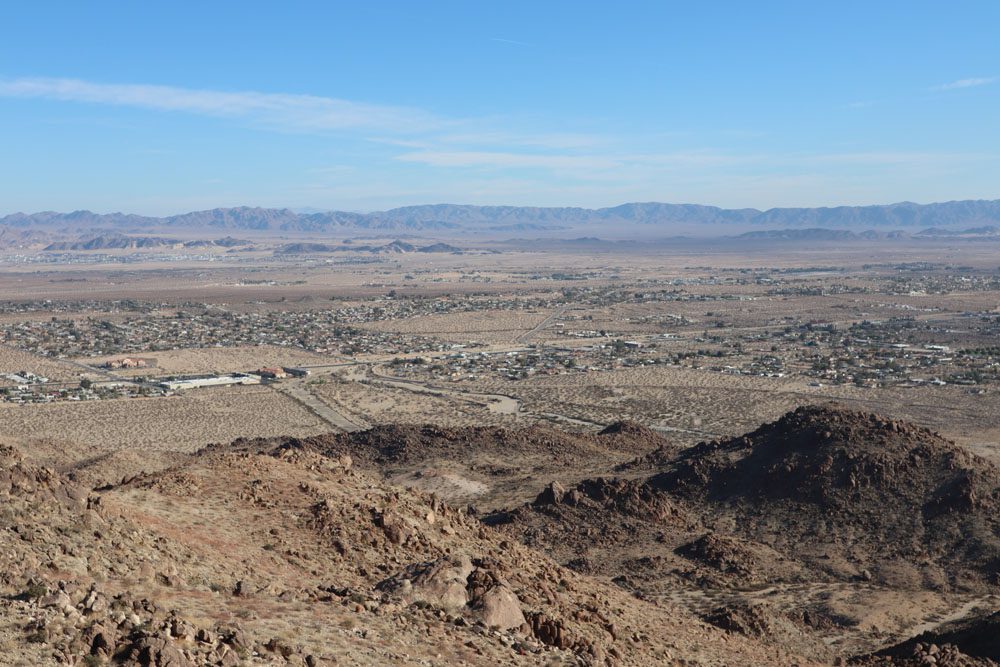
If Joshua Tree is just part of your trip to the region, using Palm Springs as a base might be a better fit. You’ll spend more than one hour in each direction driving to and from the interesting section of the national park, but you’ll find more pampering accommodation options along with restaurants and nightlife in Palm Springs.
If camping is your preferred choice, Joshua Tree NP has many available options, though it will be difficult to score a vacant spot. Five campgrounds inside the park are by reservation only, and three are on a first-come, first-serve basis. If all campsites are full, try your luck in private campsites outside the national park.
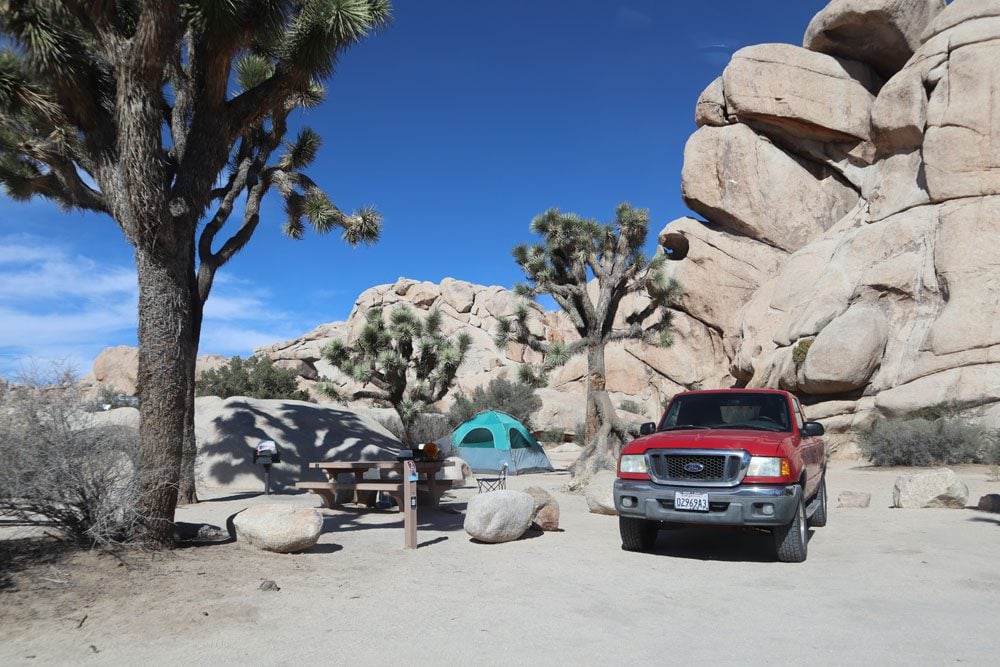
I spent a couple of nights at the simple Best Western in Twentynine Palms and used it as a base for exploring the national park. I then spent a couple of nights at the surprisingly pleasant Adara Hotel in Palm Springs.
Here’s a comprehensive list of accommodations near Joshua Tree NP that can be booked online.
Getting Around
Driving and cycling are the only means of getting around Joshua Tree National Park at the time of writing this travel guide. In 2019, the National Park Services ceased to offer a shuttle service though it might return in the future.
Distances inside the park are not huge, but they are a factor to be considered, especially if you’re staying in Palm Springs or nearby. For example, it takes about 50 minutes to drive between the north entrance to the Cottonwood Visitor Center in the south and even longer from the park’s west entrance.
A regular 2WD vehicle is sufficient for exploring the park’s major highlights, including driving on its scenic unpaved roads. However, a 4WD vehicle unlocks the opportunity to go off the grid and explore the park’s remote section via 4WD-only dirt roads.
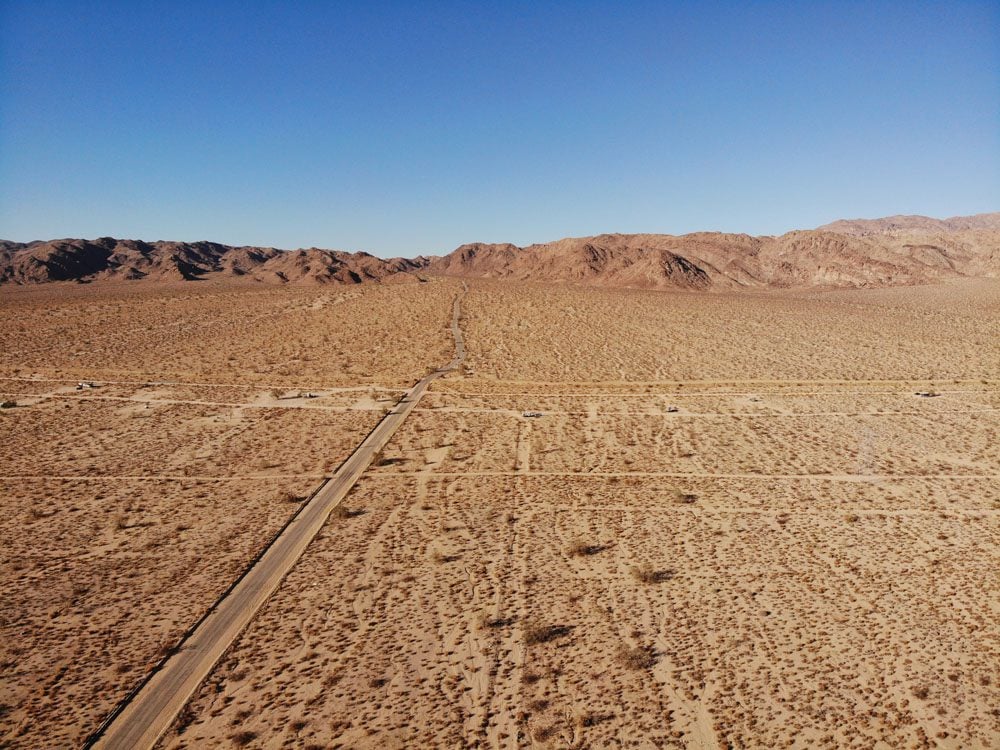
What to Do in Joshua Tree National Park
Joshua Tree National Park is famous for its high concentration of curious-looking Joshua trees. Still, there’s much more to see inside the park, including clusters of magnificently shaped boulders and extraordinary desert views. The best way to experience the park combines driving along its scenic roads and hiking.
Activity-wise, visit Keys Ranch to learn about pioneer life in the region or explore the backcountry on horseback. Joshua Tree National Park is also a popular birding and rock-climbing destination.
Water & Food
At the time of writing this travel guide, there is no food on sale inside Joshua Tree National Park. Pack plenty of snacks and aim for a picnic lunch in a scenic spot. Water should also be top of mind. Although there are several water-filling stations spread throughout the park, bring at least 1 gallon of water per person to avoid disrupting your sightseeing.
Mobile Reception in Joshua Tree NP
Don’t count on getting a signal inside the national park. This is the Mojave Desert, after all. Download an offline Google Map of the region and mark the points of interest you wish to visit before heading out. That way, you’ll still be able to navigate from point to point, even without reception. I also highly recommend purchasing All Trails Pro and downloading trail maps of the hikes on your wishlist so you can navigate offline.
What to Pack for a Trip to Joshua Tree NP
Here are a few items worth considering when planning a trip to Joshua Tree National Park and the surrounding region.
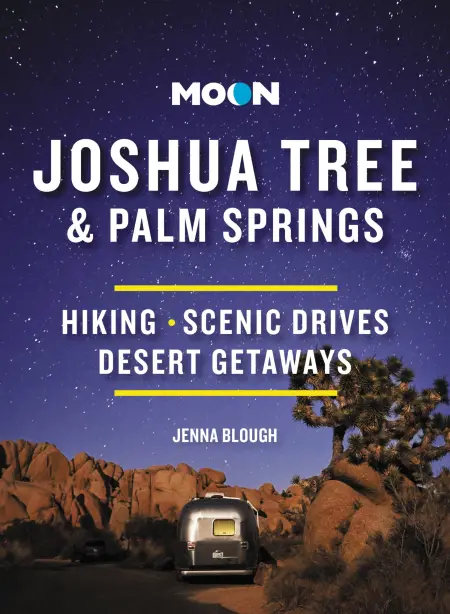
-
- Get a copy of Moon’s Guide to Palm Springs & Joshua Tree if your trip’s focus is this region. If you’re planning a California road trip, the Rough Guide to California is a great resource. Finally, if your visit to Joshua Tree National Park is part of an extended desert road trip, pick up a copy of the Lonely Planet Guide to Southwest USA.
- Hiking: proper hiking shoes, Hydration backpack, thick socks, walking poles (optional), first-aid kit, and snacks.
- Clothing: lightweight and sweat-repelling layers but also a light jacket to protect against strong winds during sunset.
- Sun protection: hat, sunscreen, sunglasses
- Dry weather: lip balm, tissues, hand cream.
- USB charger to charge your phone in the car.
- Check your car and ensure all spare tire parts are present.
Pets in Joshua Tree National Park
Pets are allowed to enter Joshua Tree National Park, but I’m not sure you’ll be able to see much in this case. Apart from remaining on a leash at all times, pets are only allowed within 100 feet of roads, picnic areas, and campgrounds. This means that you cannot hike with your pet in Joshua Tree NP.
Joshua Tree National Park Itinerary
In this section, we’ll explore an itinerary for spending up to three days in Joshua Tree National Park.
Day 1: Joshua Trees and Short Hikes
If you only have one day in Joshua Tree National Park, focus your efforts on the park’s northwest section. This is not only its more “manageable” area, in terms of relatively short driving distances and lots of sightseeing options, but also the only section where you’ll see Joshua trees.
This action-packed day keeps us inside the park until sunset. So pack accordingly with plenty of water, snacks, and something warm for the evening.
Park Boulevard
Park Boulevard connects the park’s west and east entrance stations. It is one of Joshua Tree’s main paved roads, and since it’s located in the northern section of the park, it’s your gateway to many scenic roadside stops and trailheads.
Skull Rock
As the name suggests, Skull Rock is a massive granite block eroded by nature’s forces over the years into a shape resembling a skull. The nose and eyes are owed to water accumulating on depressions in the granite. It’s an easy 1.7-mile walk to Reach Skull Rock from the trailhead, perhaps one of the reasons why this spot is so popular. Prepare to wait your turn to get close to the rock as other travelers capture the best photo for social media.

When you’ve had enough, explore the boulder-rich area behind Skull Rock. Hop from one boulder to the next in what looks like a landscape from another planet.
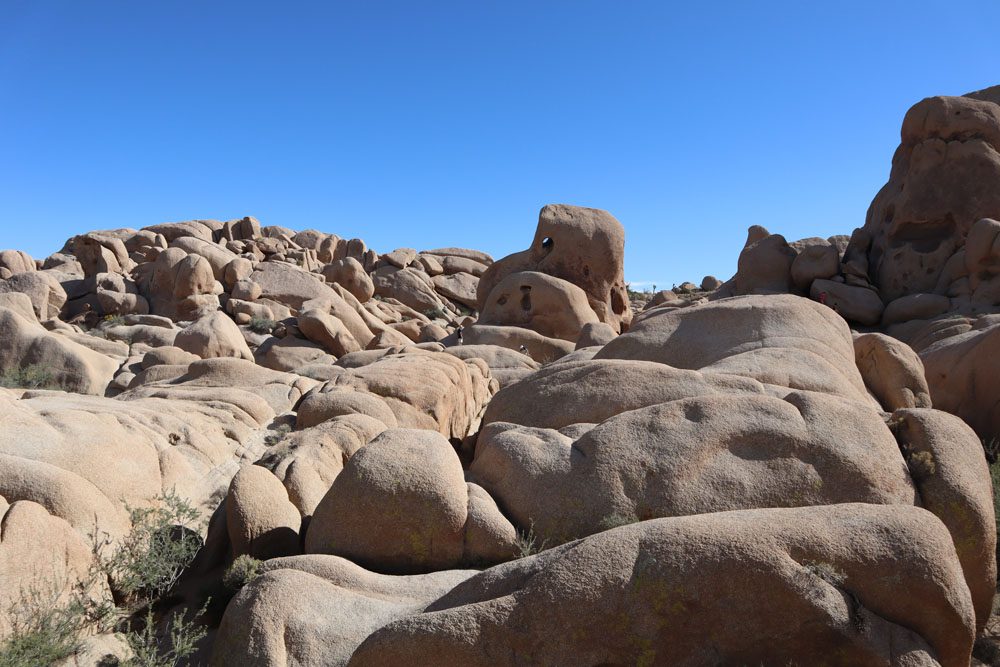
Ryan Mountain Trail
It’s still early morning, so it’s the perfect time to attempt the toughest hike of the day. Pick up the Ryan Mountain Trail and quickly ascent just over 1,000 feet to the summit. This is without a doubt one of the best hikes in Joshua Tree NP, offering exceptional panoramic views as far as the eye can see. From the summit (5457ft), notice how clusters of boulders break an otherwise barren desert landscape, surrounded by peaks and sprinkled here and there with Joshua trees.
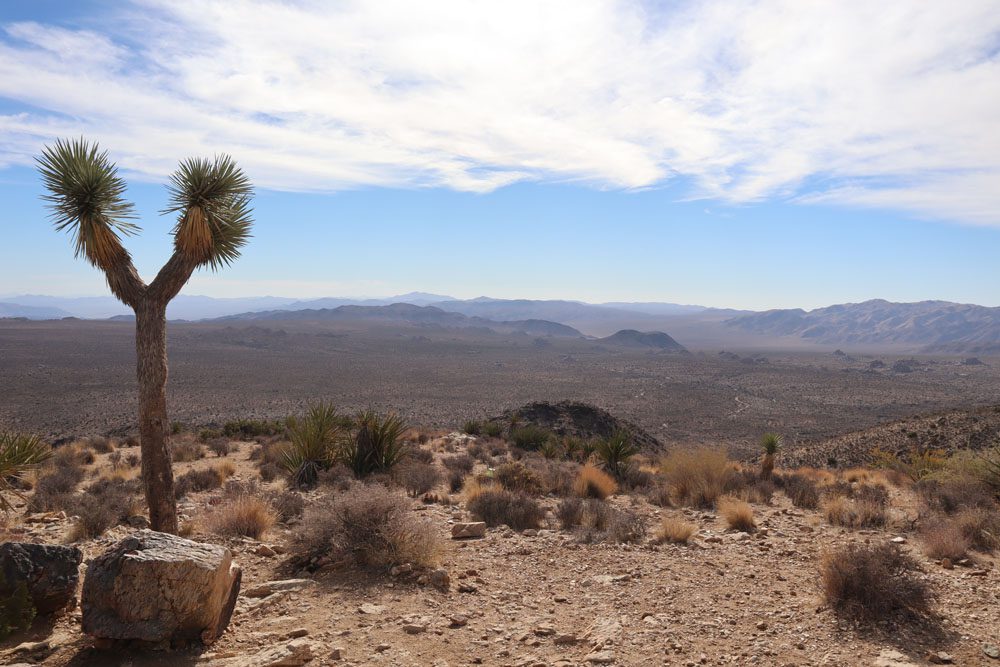
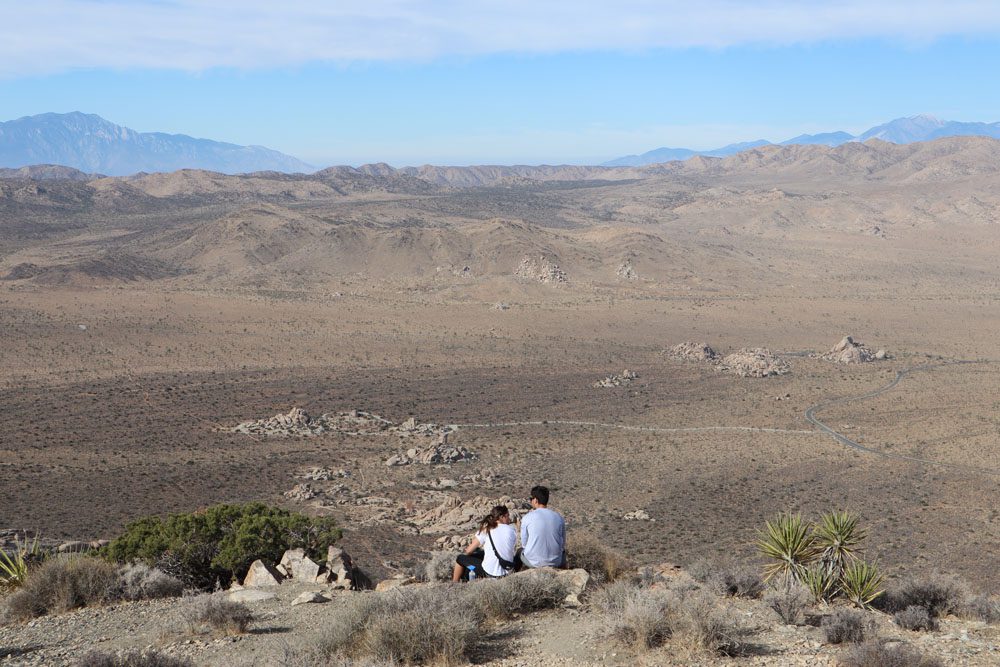
(1) Prepare for windy conditions at the summit and just a little less than 1.5 hours to comfortably complete the hike. (2) For an easier hiking option in the area without the elevation gain, check out the Ryan Ranch Trail.
Hall of Horrors
Seen from the summit of Mount Ryan, the Hall of Horrors is one of the bizarre-looking rock clusters that appear to be out of place. From the parking area, go for a stroll and perhaps organize a game of hide and seek. Joshua trees also grow in abundance in this area.
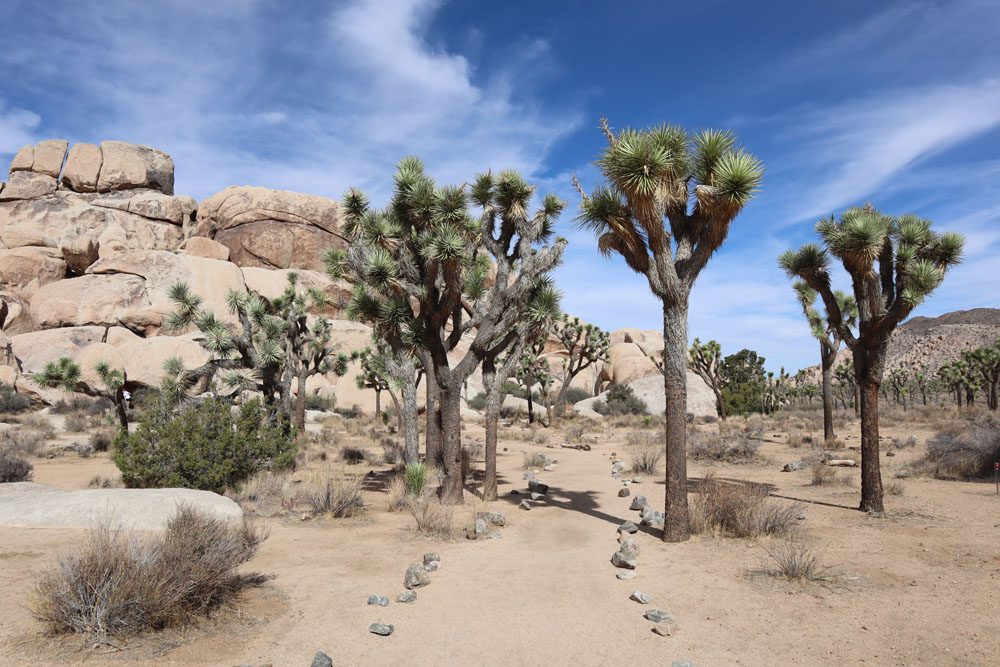
Hidden Valley Nature Trail
The easy one-mile Hidden Valley Nature Trail is one of the most enjoyable hikes in the national park. This 55-acre area is partially enclosed by smooth boulders piled on top of each other, hence the name. It is said that rustlers used Hidden Valley in the old days to hide stolen cattle.
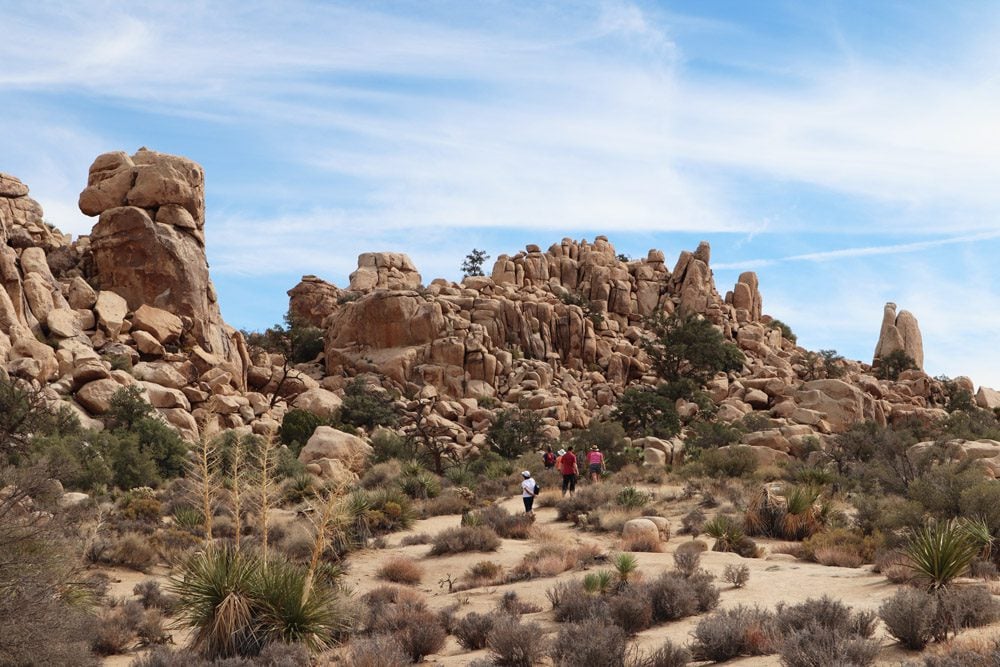
Interpretive plaques along the way explain the valley’s history and the flora and fauna that can be seen. In 1936, local rancher Bill Keys is believed to have blasted an opening through which visitors now enter Hidden Valley, just months before the area became a national park.
Barker Dam Nature Trail
The easy 1.1-mile Barker Dam Nature Trail is similar to our previous stop, though it offers more diversity and should not be skipped. Apart from the beautiful rocky landscape and Joshua trees, the trail’s first point of interest is the modest petroglyph site.
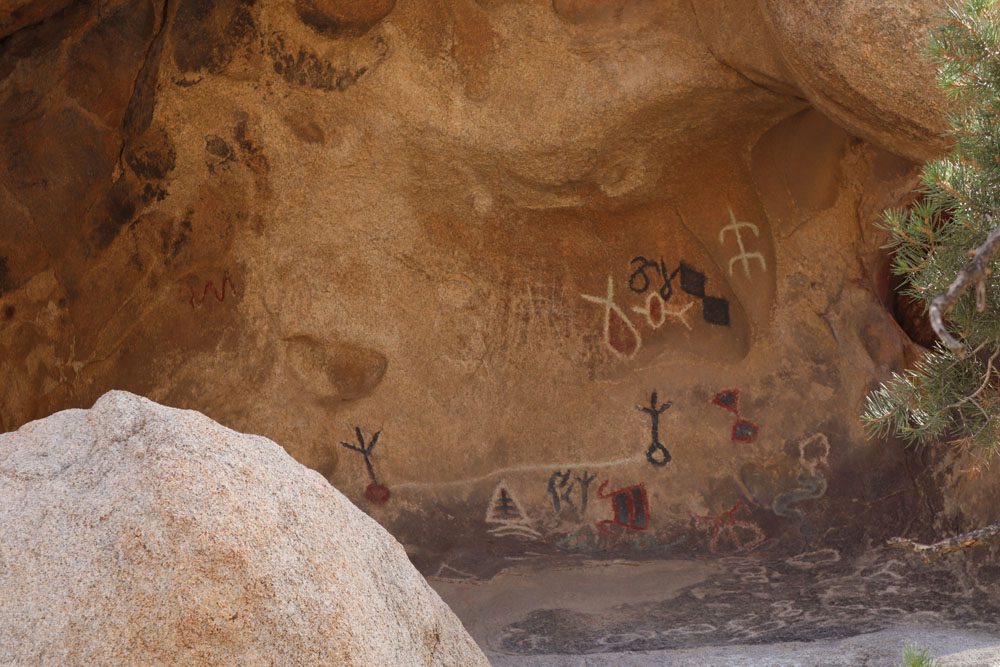
From the petroglyphs, continue to Barker Dam, though it might be dry. The lower dam was completed in 1902, and an upper concrete layer was added in 1950. Barker Dam is a testament to the area’s cattle ranching history and the crucial importance of every drop of water.
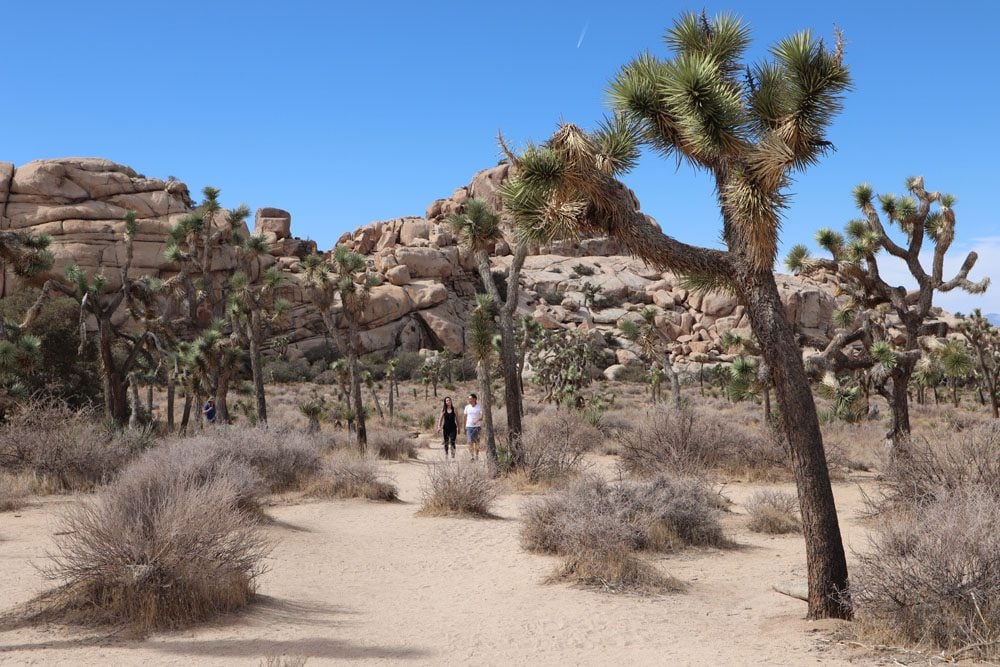
Stay away from the crowds as you begin the trail and keep your senses on high alert for a chance to see resident woodrats at work.
Wall Street Mill Trail
If you’re doing well on time and energy, pick up the Wall Street Mill Trail as it merges with the Barker Dam Trail. Alternatively, return to your car and drive a short distance to the trail’s official parking. This will shave a few minutes from the return hike had you left it by the Barker Dam trailhead. The easy two-mile trail begins with an optional detour to a photogenic abandoned home.
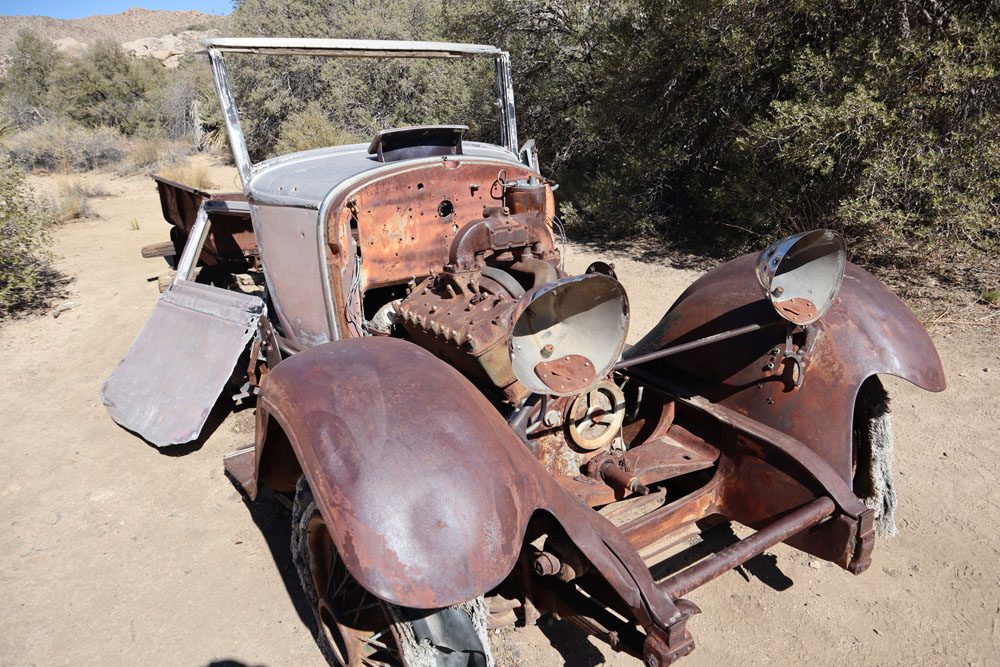
However, the main attraction is the ruins of the Wall Street Mine. Beginning as a gold mine in 1928, the land was purchased by rancher-miner William Keys, who set up a two-stamp gold ore crushing mill along with other structures. Keys offered the use of the machinery to the area’s miners. Once gold was separated from the ore, it was sent to nearby smelting facilities. The mine officially closed in 1996, three years before Keys’ death.
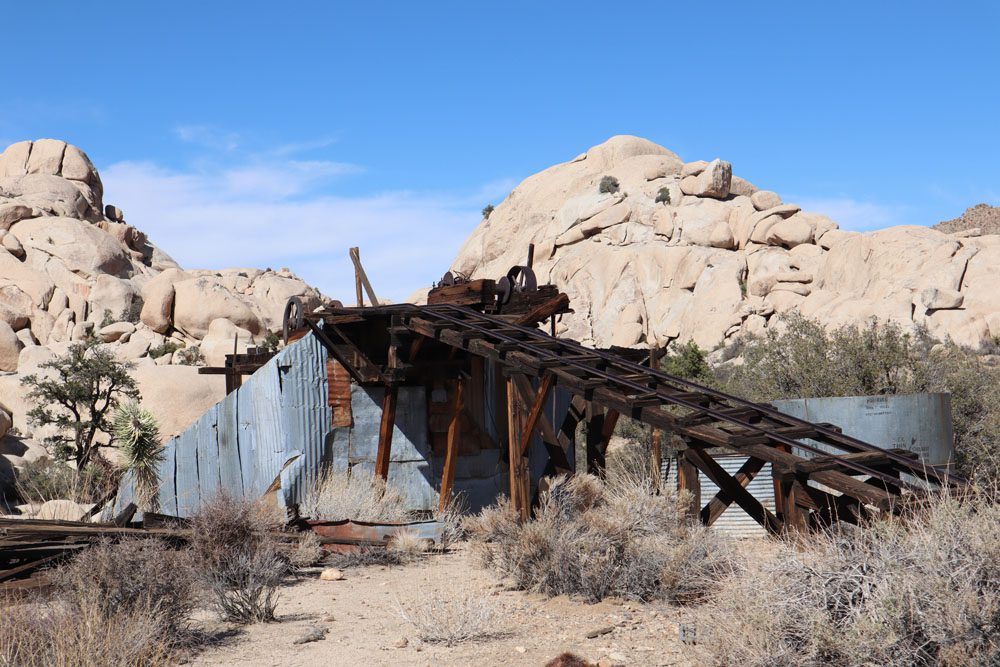
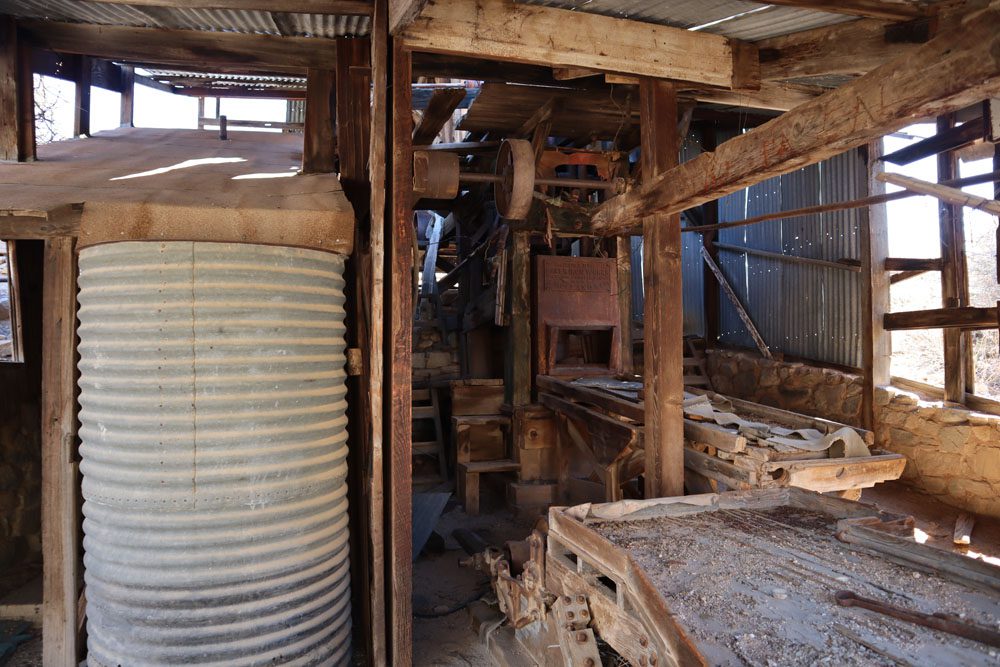
William (Bill) and Frances Keys are perhaps the area’s most famous residents. Through hard work, entrepreneurial spirit, and technical ingenuity, the couple raised five children in one of the most hostile environments in America. If you’re only spending one day in Joshua Tree National Park, squeeze in a visit to the Keys Ranch. Book advance tickets for the ranger-led tour.
Pinto Basin Road
From our last stop, drive west on Park Boulevard and turn right on Pinto Basin Road. This is the park’s second main paved road, ending at the Cottonwood Visitor Center. Pinto Basin Road slices through the barren heart of the national park, the geographic region where the Mojave and Colorado deserts meet. You won’t see any Joshua Trees along on the drive, but you will be treated to beautiful desert scenery and lots of tumbleweeds on windy days.
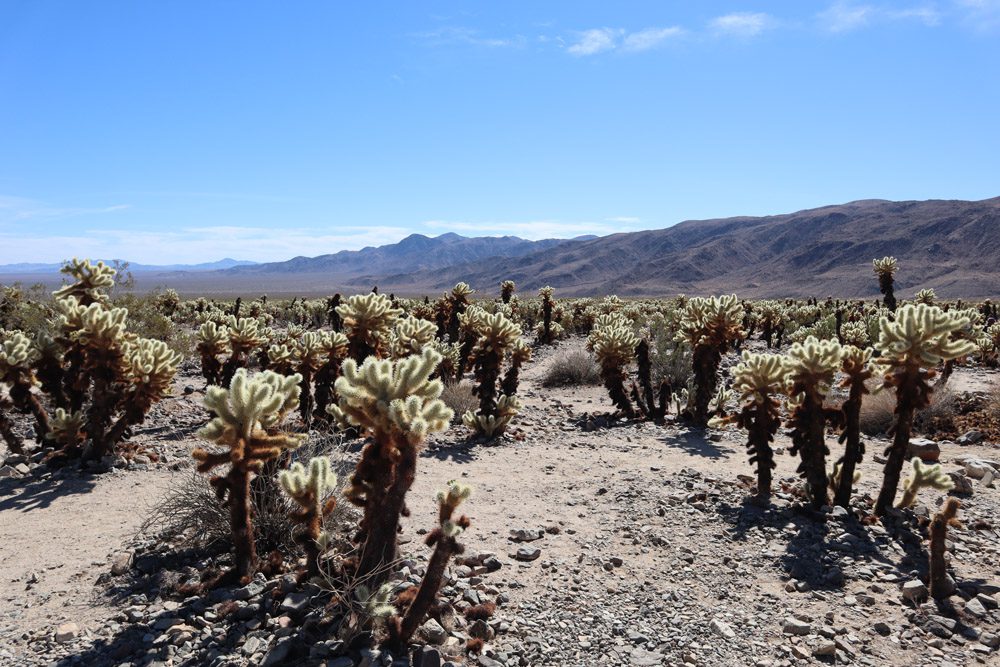
Cholla Cactus Garden
The Cholla Cactus Garden is located more or less in the heart of Joshua Tree National Park. In this enchanting spot, a thorny oasis grows in an otherwise barren landscape. Explore the garden along a quarter-mile trail but be careful not to touch the cactuses as their thorns easily break off and attach to humans and animals.
The Cholla Cactus Garden is especially impressive during dusk and dawn.
Arch Rock Trail
There’s one last activity to do before heading to our final stop. Though not as impressive as the natural rock arches in Utah’s Arches National Park, here’s a great opportunity to see one without much effort. From the Twin Tanks parking lot, pick up the short and easy Arch Rock Trail. The trail crosses the paved road and heads inland towards a cluster of smooth boulders. Walk around until you locate the small arch, which won’t be here forever, thanks to the forces of erosion.
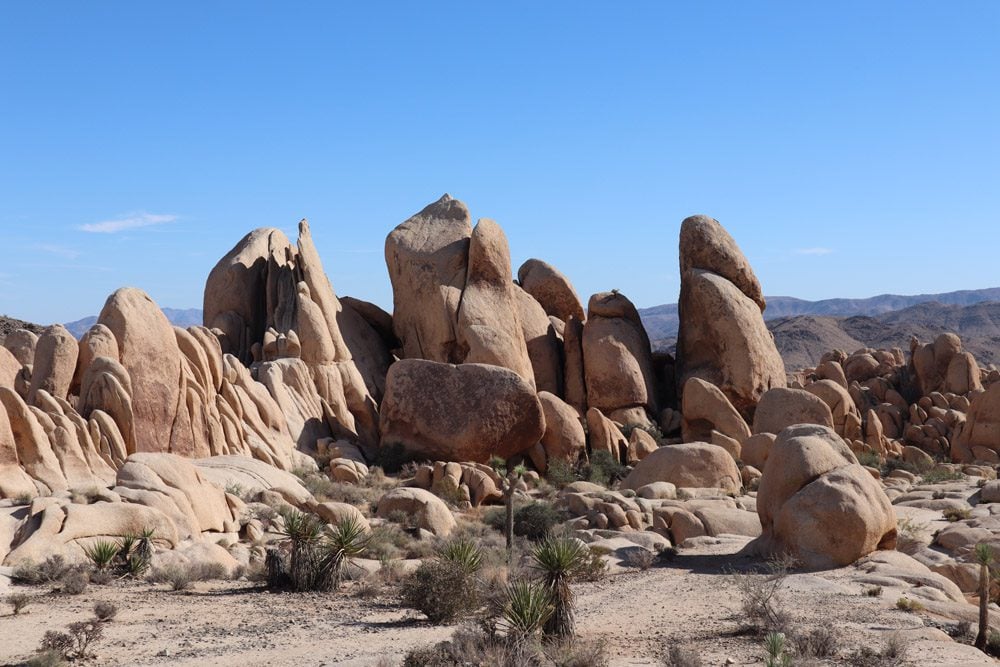
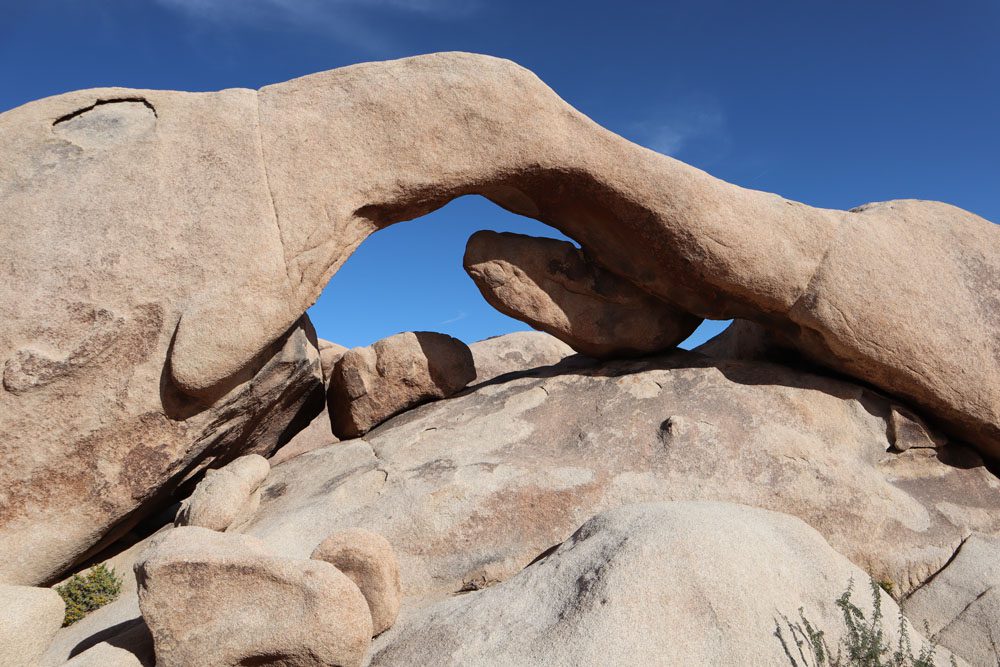
Sunset at Keys View
Drive to Keys View to watch the sunset in Joshua Tree National Park but aim to arrive 30-45 minutes before the daily spectacle since this spot is no secret. Overlooking the Coachella Valley and surrounding peaks from 5185ft, the panoramic scenery from Keys Views is unparalleled throughout the park. However, smog funneled through nearby mountain passes usually leads to hazy conditions.
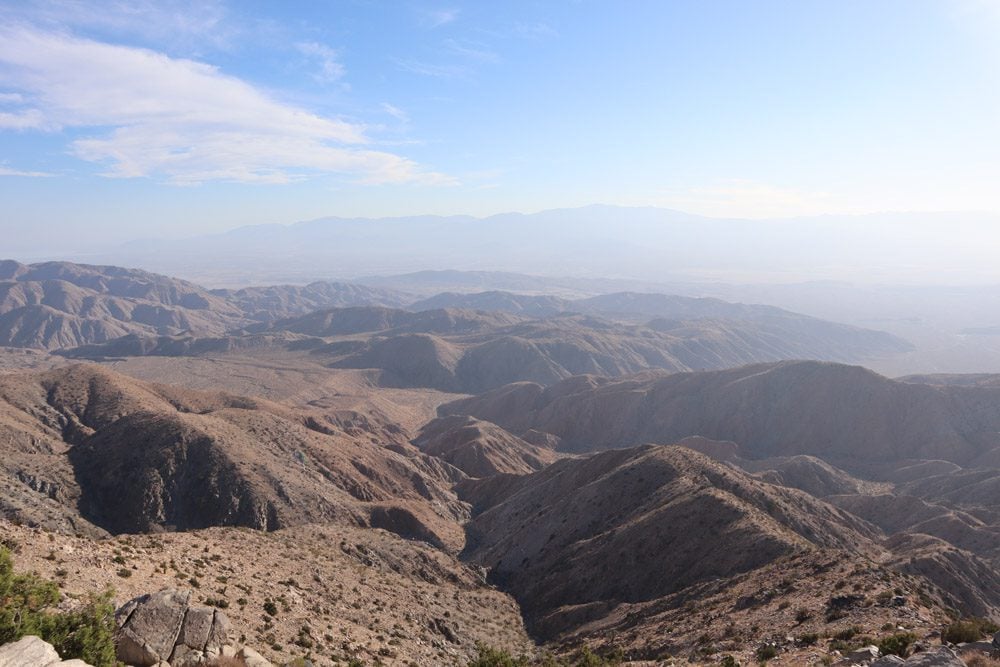
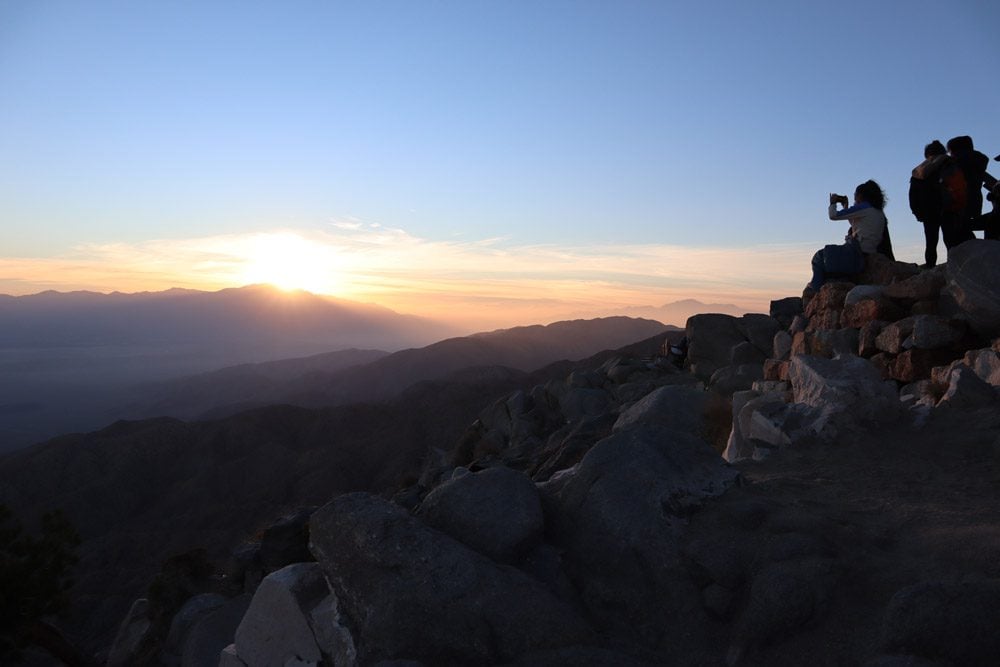
(1) It will be cold and windy up here, so pack something warm. (2) This is a great spot to make a time-lapse video, so bring a tripod. (3) Most visitors tend to stick to the viewing area. Walk slightly beyond for a better chance of finding a more secluded spot.
Stargazing
If you don’t want to return to your hotel or campground, stick around for some stargazing. Joshua Tree is an International Dark Sky Park, so stargazing conditions are optimal nearly throughout the park. Watch the night sky from just about anywhere, or head to the Sky’s The Limit Observatory if any programs are taking place.
Day 2: Lost Palms Oasis & Around
The second day of our Joshua Tree National Park itinerary focuses on the park’s southern section. Today’s plan is to mix hiking with nearby attractions outside the national park. Of course, you can move some of yesterday’s highlights to this day, keeping in mind driving times inside the park and back to your accommodation.
Cottonwood Visitor Center
If you’re driving to the national park from Palm Springs or nearby, enter via the south entrance and briefly stop at the Cottonwood Visitor Center to check if any ranger-led programs are on the schedule and to fill your water bottles. If you’re based in Twentynine Palms or around, drive the length of Pinto Basin Road.
Along the drive, you’ll transition from the Mojave Desert to the Colorado Desert and notice how Joshua trees are nowhere to be found. You can also stop at the Cholla Cactus Garden, but I advise driving straight while the temperature is still moderate.
Mastodon Peak Trail
The Mastodon Peak Trail begins at the Cottonwood Spring Oasis parking lot and loops around Mastodon Peak. However, you can combine this hike with the Lost Palms Oasis Trail by taking the left trail at the fork and later merging with the Lost Palms Trail. Pass through the lush Cottonwood Spring before the parking lot on the return leg. The Mastodon Peak Trail is easy-going, except for the optional section where you must scramble to the summit. The trail also leads to a small abandoned mine.
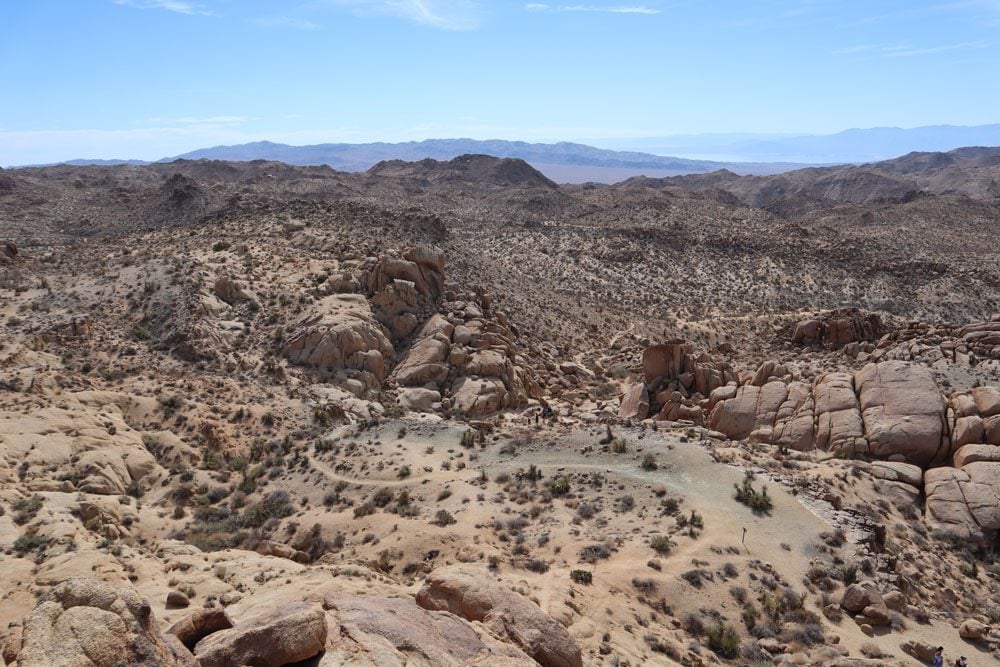
Lost Palms Oasis
This moderately difficult in-and-out 7.5-mile hike heads to one of the remotest sections of Joshua Tree National Park, so pack accordingly. Hikers on the Lost Palms Oasis Trail spend most of their time hiking on a flat surface, often crossing through dry sandy washes in a surprisingly rich landscape featuring a wide array of desert plans.
The final leg brings you to the Lost Palms Canyon and its oasis, a remote and secluded collection of large fan palms. Enjoy the views from the top or carefully scramble down to get closer to the oasis. I found a comfortable spot and enjoyed the silence that was only broken by the sounds of flying crows, swaying palms, and the occasional high-flying commercial jet.
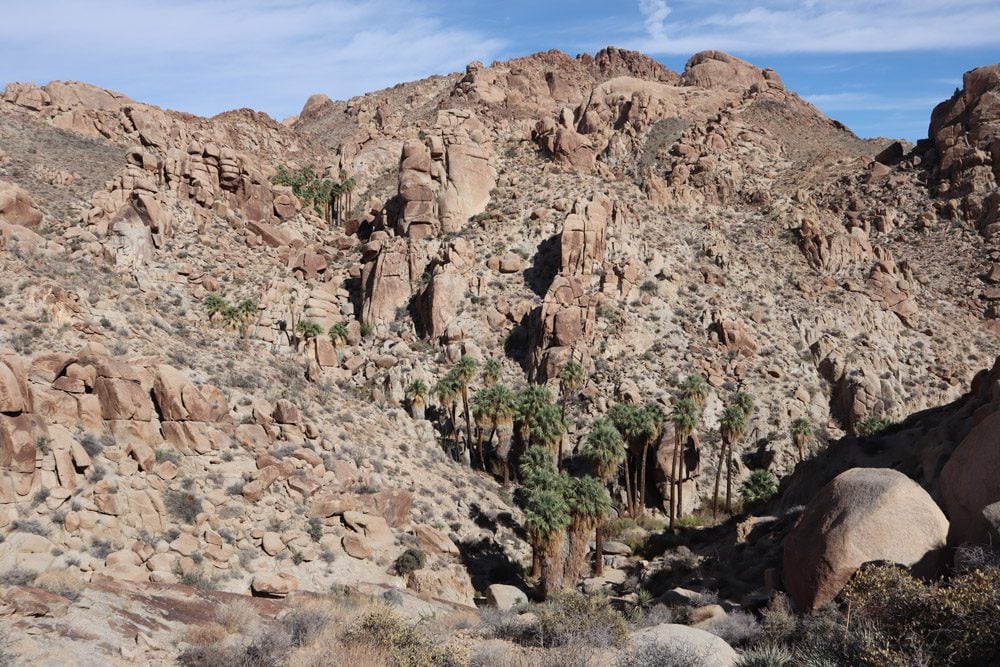
If you don’t have the time for this long hike or don’t plan to visit the southern section of the national park, consider the shorter Fortynine Palms Oasis Trail. See tomorrow’s itinerary for more details.
Spending the Rest of the Afternoon
Spend the rest of the afternoon either visiting places from the first day’s itinerary that you didn’t complete or exit the park and head to one of the recommended options. All driving distances are measured from the Cottonwood Visitor Center.
At the Sonny Bono Salton Sea National Wildlife Refuge (1.5 hours), head to the visitor center and try spotting cormorants, terns, and pelicans. Next, at the Shields Date Garden in Indio (45 mins), stroll around the lovely Bible-themed desert oasis, treat yourself to a well-deserved lunch, and grab a date smoothie before heading to your hotel. Finally, at Cabot’s Pueblo Museum in Desert Palm Springs, visit the historic house museum built in Hopi style and containing interesting Native American artifacts.
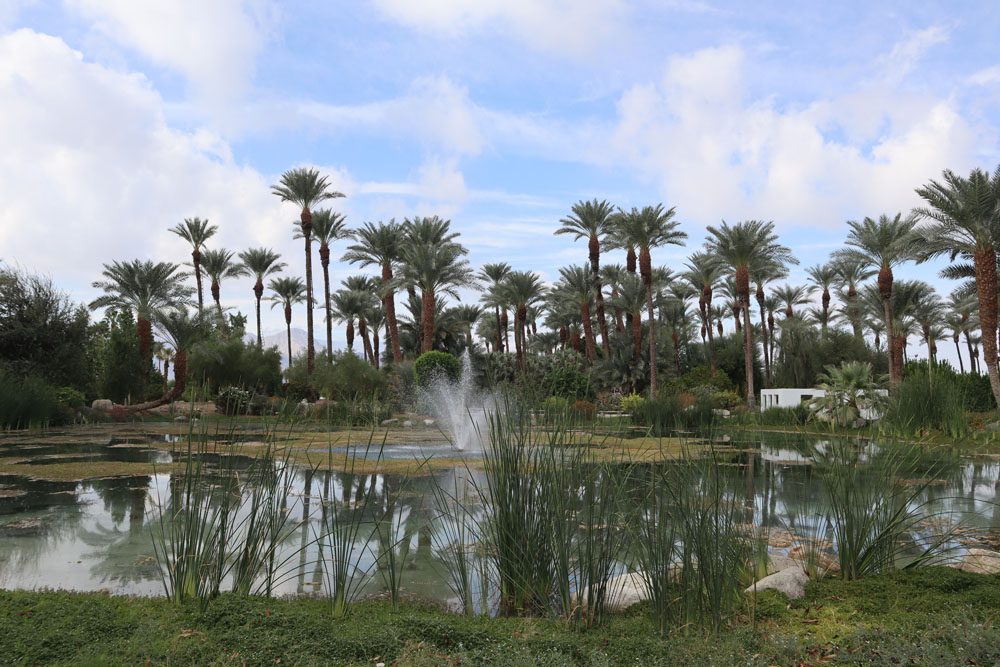
Day 3: Fortynine Palms, Geology Tour & Around
If you’re spending three days in Joshua Tree National Park, focus the last day of your itinerary on the park’s northern section, visiting places we skipped on day one and exploring interesting spots outside the national park.
Fortynine Palms Oasis
Start the day on the Fortynine Palms Oasis Trail, a moderate hike that begins just outside the small town of Twentynine Palms. The trail first ascends to the high ground via a rocky desert landscape dotted with small cactuses and great panoramic views of the surrounding communities. It then descends to the narrow canyon and its lush oasis. Find a secluded spot and listen to the symphony of birds and swaying palms. I didn’t count 49 palms, but there sure were a lot at this oasis.
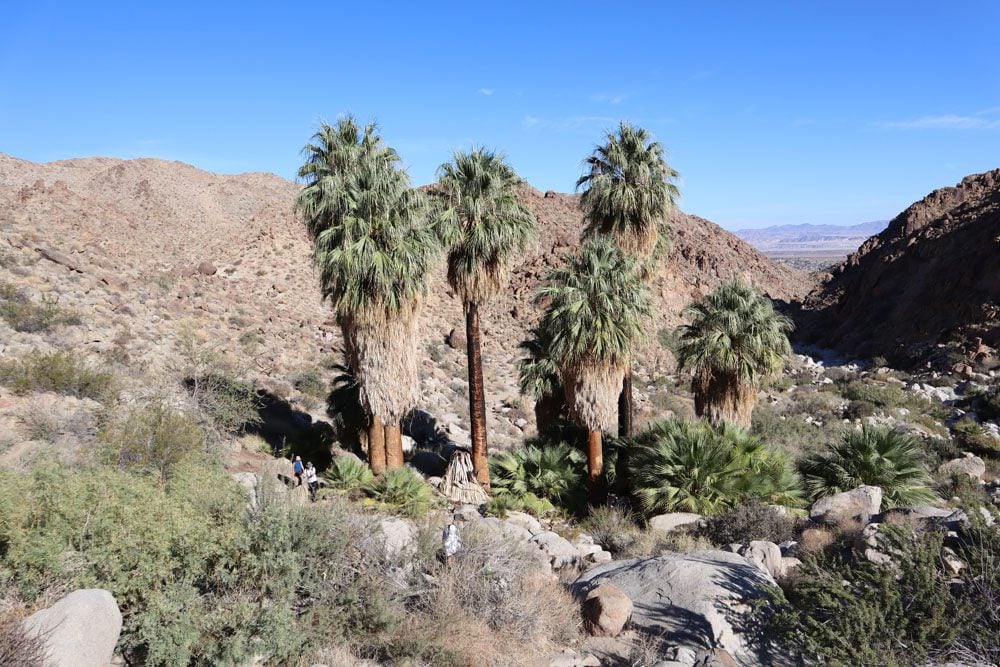
(1) Access to Fortynine Palms Oasis is restricted during the summer to allow bighorn sheep undisturbed access to surface water. (2) The hike is best appreciated in the early morning and late afternoon when there are better chances of spotting wildlife. (3) The oasis is also a great spot for a picnic breakfast or lunch.
Oasis of Mara
The Oasis of Mara is an alternative to the previous hike or if you just can’t get enough desert oases. The short trail begins at the Oasis Visitor Center, and plaques along the way peel the layers of interesting history that took place at this significant spot.
Keys Ranch
If you didn’t visit the Keys Ranch or if there weren’t any available tickets, here’s another chance to visit the historic home of pioneer couple William and Frances Keys.
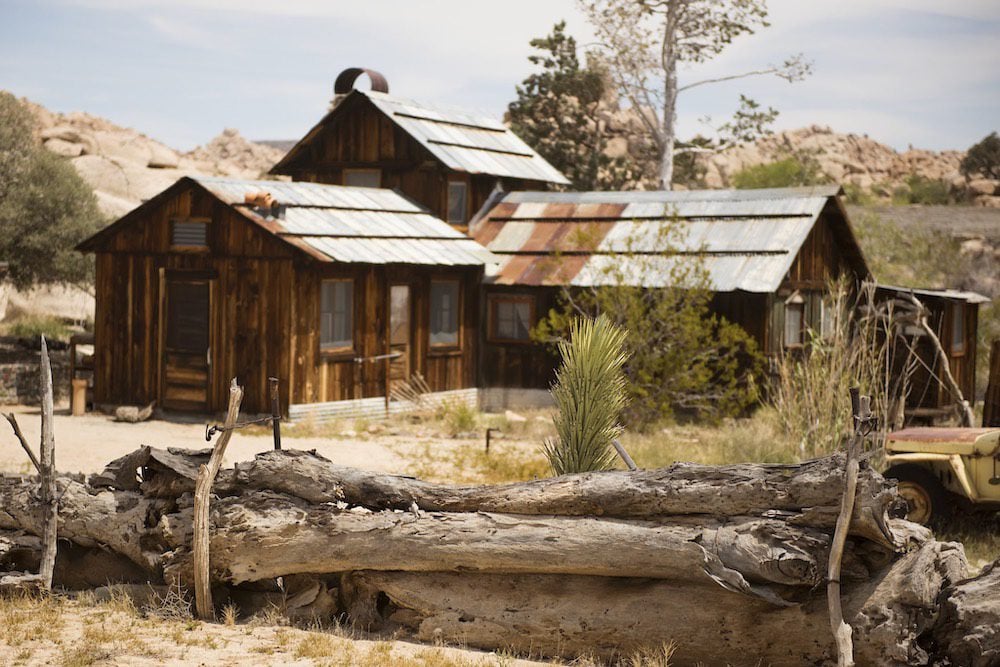
Geology Tour Road
Witness Joshua Tree’s 1.8 billion-year geological history on the Geology Road Tour. The 18-mile dirt is accessible to most passenger vehicles up to a section beyond which the road becomes suitable for 4WD vehicles only. The scenic route offers many chances to pull over and enjoy the views.
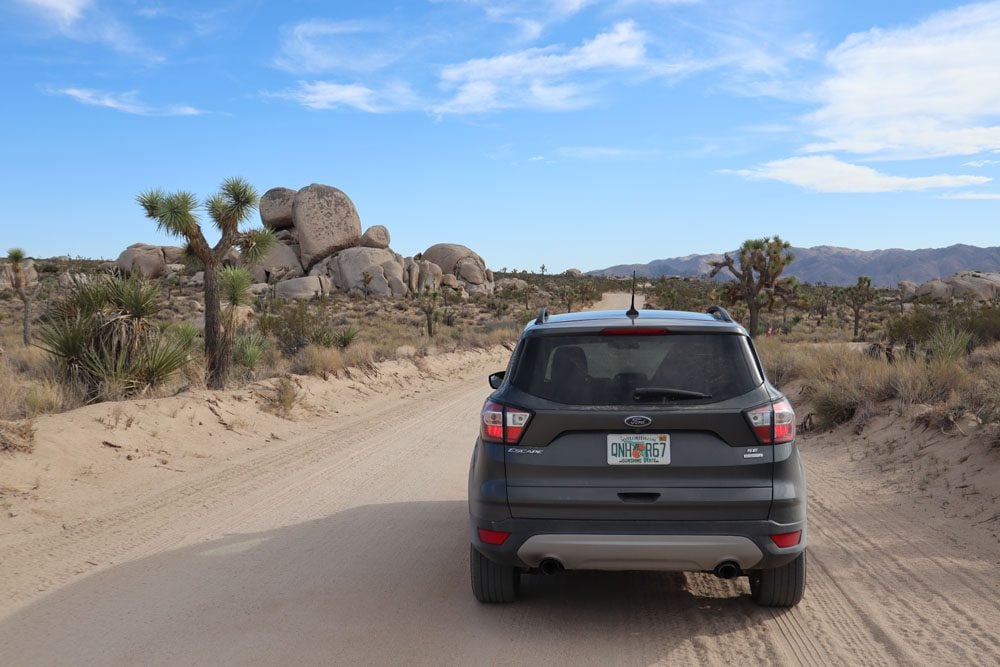
Afternoon Options
Like yesterday, the afternoon presents the opportunity to rest your legs and visit interesting sites outside the national park. All driving distances are measured from Twentynine Palms.
Take a guided tour of the Integratron in Landers, and learn about this bizarre wooden dome built in the 1950s as a pseudo-scientific-spiritual experiment (35-minute drive). Drive to the Giant Rock to see the giant desert boulder that’s believed to be at the center of UFO activity (45-minute drive). Lastly, go off the grid by driving on Amboy Road through the middle of nowhere to an old section of Route 66 (50-minute drive).
What’s Next?
With this Joshua Tree National Park travel guide and itinerary, you’re now ready to start planning your road trip to one of the prettiest areas in America for desert lovers. Spend anywhere from one to three days in Joshua Tree NP and combine your visit with a stay in Palm Springs, additional California gems, or hit the road to the next stop in the American Southwest.
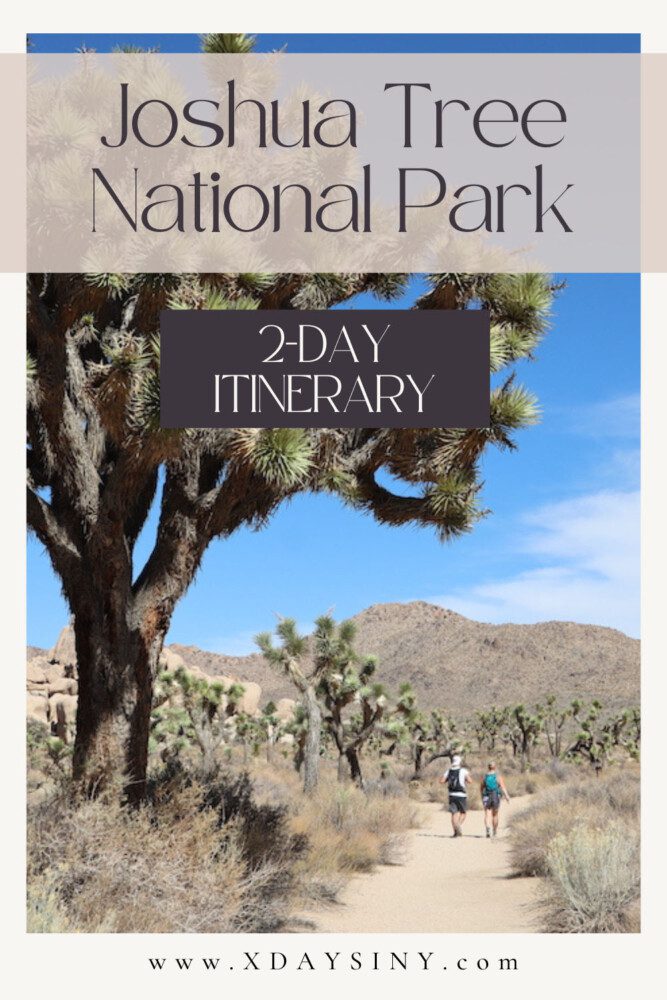
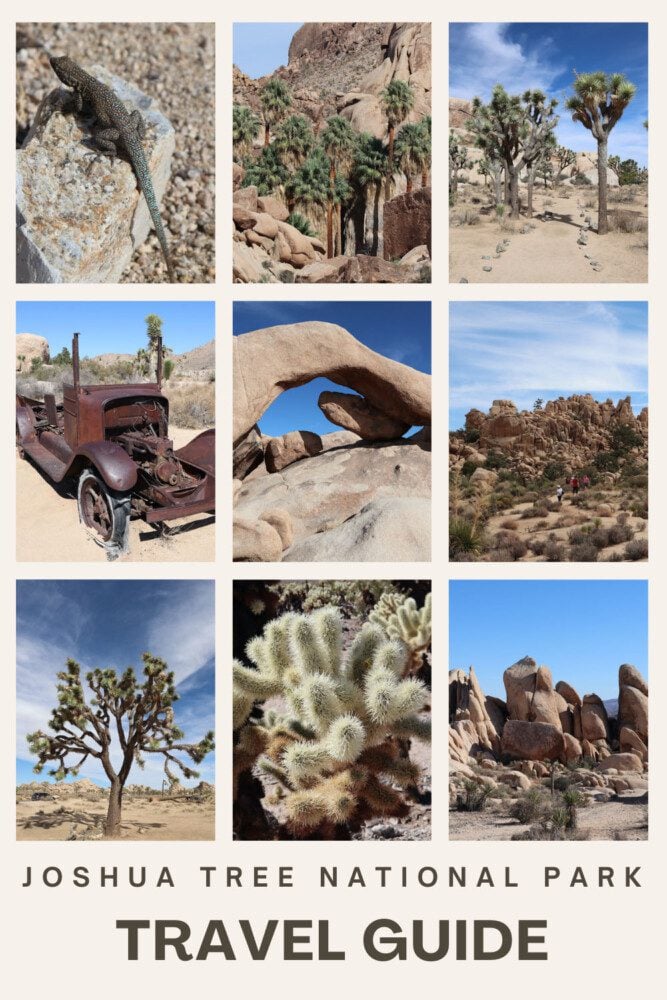
Pin These Images To Your Favorite Boards
Frequently Asked Questions
Joshua Tree National Park is located near Palm Springs in southeast California, in a region where the Mojave Desert meets the Colorado Desert.
There are three ways to enter the national park: the west entrance near the town of Joshua Tree and the Joshua Tree Visitor Center, the north entrance near Twentynine Palms and the Oasis Visitor Center, and the south entrance near the Cottonwood Visitor Center off Interstate 10.
The best time to visit Joshua Tree National Park is during spring and late fall, when daytime and evening temperatures are optimal.
On a one-day visit to Joshua Tree National Park, focus on the more “manageable” northwest section of the park. You can comfortably cover all the park’s major highlights on a two or three-day visit, including several long hikes.
Stay in Twentynine Palms if the main motivation for your trip is to explore the national park. This small town has many motels, restaurants, and essential services. It’s also less than 10 minutes by car from the park’s northern entrance.
Day 1: the park’s northwest section covering Park Boulevard.
Day 2: Mastodon Peak and Lost Palms Oasis
Day 3: Fortynine Palms and Geology Tour
